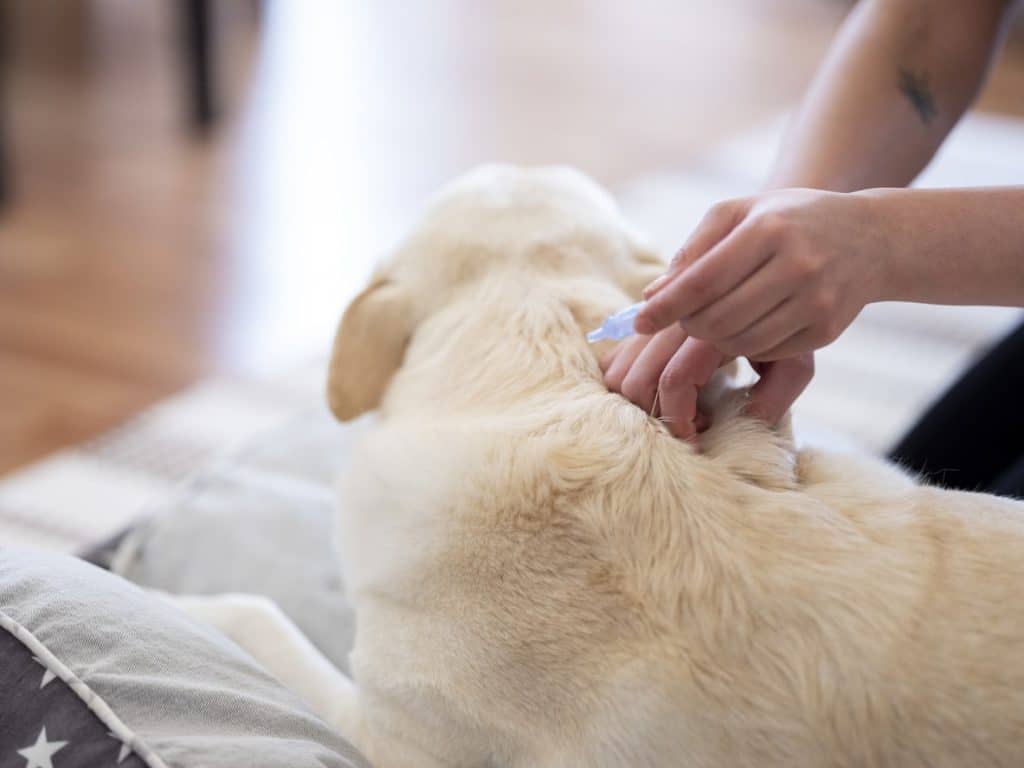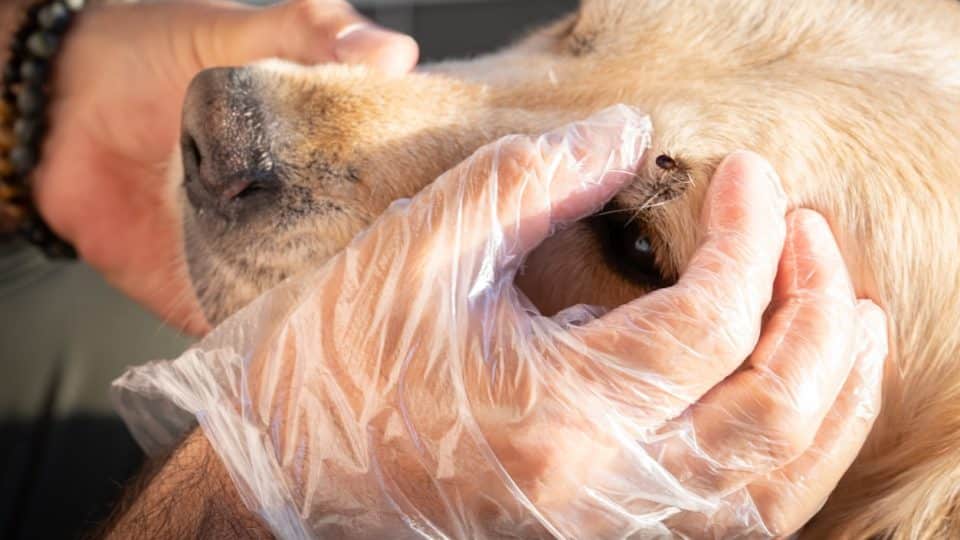- Not a substitute for professional veterinary help.
If you’ve spotted a tick on your dog, it’s time to remove it quickly and safely at home. Carefully remove the head of the tick with fine-point tweezers, explains Dr. Nicole Eckholm, a veterinary dermatologist and owner of Golden Gate Veterinary Specialists.
Other essential supplies for getting rid of ticks include wipes, gloves, and a jar with a lid.
Let’s learn how to take ticks off your dog the right way and what to do afterward to keep your dog free from ticks in the future.
How to Prep for Tick Removal
Safe tick removal starts with the right supplies. Here’s what you’ll need at home:
- Tweezers: Fine-tipped tweezers can grasp the tick as close to the skin as possible, advises Dr. Wonjae Lee, DVM, medical director at Blue Cross Pet Hospital.
- Gloves: Wear gloves since some tick-borne diseases can be transmitted through cuts or breaks in your skin.
- Jar with a lid: After removing the tick, put it in the jar. Then, you can dispose of it safely.
- Antiseptic wipe: An antiseptic wipe can clean the bite site after removing the tick.
How to Remove a Tick From a Dog in 6 Steps
Now that everything is ready, it’s time to remove the tick. Here’s a step-by-step guide to help you do so safely.
1. Set up a calm environment
Sometimes, getting your dog to sit still is the hardest part of taking off a tick! A stressed pup can make tick removal much harder, so try these tips to get ready:
- Get a helper: Have someone help keep your dog calm and still while you remove the tick.
- Distract them: Use a dog chew or a slow feeder to keep your dog busy.
- Find a well-lit area: You’ll want to see the tick clearly when removing it so move into a well-lit area or use a headlamp.
2. Hold the tick tightly
Use tweezers with a fine tip to hold the tick as close to your dog’s skin as you can.
Ticks can spread diseases through their mouth and saliva. To make sure the mouth is removed, hold the tick near its mouthparts.
Steve Dale, a certified animal behavior consultant, suggests not to squeeze the tick’s body. This stops other tick fluids from getting into your dog.
3. Pull with steady, gentle pressure
Gently pull the tick straight out with even pressure. Don’t twist or yank it; that might break the body off and leave the head stuck.
Call your vet if you pull the tick out and see that the head is missing. Parts of the tick left in your dog’s skin can cause an infection
4. Get rid of the tick properly
After you remove the tick, put it in a jar or other safe container. This keeps it from getting lost in your house.
Write down the date and time you took the tick out of the jar. “If pet parents are able to save the tick veterinarians are sometimes able to identify risk level for the pet,” explains Dr. Eckholm.
If you don’t want to keep the tick in your house, Dale says to take a picture of it so your vet can identify the type. Then, you can flush the tick down the toilet or put it in rubbing alcohol to kill it.
5. Clean the bite site
Dr. Eckholm says pet parents should clean the bite area with an antiseptic wipe.
Importantly, check your dog’s body to ensure no other ticks are present too.
6. Monitor your dog
Luckily, Dr. Lee says if pet parents remove the tick within a day, the likelihood of illness is small.
However, keep an eye on your dog for symptoms of tick-borne illnesses, including:
- Skin irritation
- Redness
- Swelling
- Pus at the bite site
If you notice any of these signs, take a trip to the vet.
What Not to Do When Removing a Tick
There are many “old wives tale” ways to remove a tick. However, don’t try to take off a tick by covering it with nail polish, alcohol, vinegar, or Vaseline (petroleum jelly). These methods can cause a tick to release more harmful saliva into your dog.
Also, never try to burn a tick off with a lit match. This can also make the tick release more saliva and might burn your dog’s skin and fur.

iStock/temizyurek
What to Do After You Remove a Tick
Even if you remove the tick, keep an eye on your dog for signs of illnesses from ticks.
Dr. Lee says to watch out for:
- Lethargy
- Lack of appetite
- Joint pain
- Swollen lymph nodes
- Fever
If you see any of these signs, take your dog to the vet right away, even if your dog just seems a little “off.” Early treatment can help your dog get better faster.
Ticks can transmit many different diseases, including:
- Rocky Mountain spotted fever
- Ehrlichiosis
- Q fever
- Lyme disease
- Tick paralysis
Ticks can also release toxins that can affect more at-risk dogs, like puppies and dogs with health problems.
How to Prevent Ticks on Your Dog in the Future
Preventing ticks is the best way to keep your dog safe. Dale says vets can give pet parents the right tick medicine for their lifestyle and geography.
Here are some other tips to prevent tick-borne illnesses:
- Give your dog tick medicine: Give your dog monthly flea and tick medicine. These can be liquids you put on their skin or chewable tablets.
- Check them daily: Even with medicine, you should check your dog for ticks every day, especially after walks or any time outside.
- Watch where you walk: When you walk your dog, stay away from tall grass and areas with lots of plants. Ticks like to hide in these areas.
- Wear tick-protective gear: Dr. Lee suggests using special clothing and gear for your dog in places with lots of ticks. This clothing keeps ticks from getting on your dog.
Using several of these methods can help keep ticks away. It’s always easier to prevent ticks than to remove them later!



